Table of Contents
The Great Dane, often referred to as the “gentle giant,” is a breed that embodies both elegance and affability. If you’re new to the world of dogs, especially the grandeur of the Great Dane, let’s embark on a journey to Unveil the majesty of the Great Dane, a large and noble breed with German origins. From its hunting heritage in the Middle Ages to its position among the world’s largest dogs, explore the remarkable journey of these gentle giants.
Introduction to the Great Dane
History and Origins of Great Danes
Originating in Germany, not Denmark, the Great Dane boasts a heritage spanning over 400 years. These gentle giants trace their lineage back to mastiff-like canines, selectively bred by German nobles for safeguarding estates and hunting wild boar. In the 18th century, these remarkable dogs stood as prestigious protectors of estates and carriages. What about Legacy Great Danes?
Physical Characteristics of Great Danes
Envision a dog that could easily measure up to your height when standing on its hind legs. That’s the Great Dane for you! These giants come in various coat colors, including shades of fawn, brindle, blue, black, and harlequin patterns. But it’s not just their size that captures attention – their sleek build and dignified stance make them true four-legged aristocrats. Do you know that world’s tallest dog confirmed as Zeus the Great Dane according to the Guinness World Records.

Average lifespan, height, and weight of male and female Great Danes:
| Attribute | Male Great Dane | Female Great Dane |
|---|---|---|
| Lifespan | 8 to 10 years | 8 to 10 years |
| Height | 30 to 35 inches (76 to 90 cm) at the shoulder | 28 to 33 inches (71 to 84 cm) at the shoulder |
| Weight | 120 to 200 pounds (54 to 90 kg) | 99 to 130 pounds (45 to 60 kg) |
Remember, these are general averages, and individual Great Danes may fall outside these ranges. Proper care, nutrition, and regular veterinary check-ups can contribute to a longer and healthier life for your beloved gentle giant.
The 7 Types of Great Dane Colors, Patterns & Markings
- Fawn Great Dane: The Fawn Great Dane is a gentle giant known for its warm, golden coat and friendly disposition. These majestic dogs are as striking in their appearance as they are in their affectionate nature. Read more : Fawn Great Dane: Everything You Need to Know
- Brindle Great Dane: The Brindle Great Dane boasts a unique coat pattern resembling tiger stripes, making it a standout among its peers. This breed is admired for its regal appearance and gentle temperament. Read more: Brindle Great Danes: Everything You Need To Know
- Harlequin Great Dane: The Harlequin Great Dane is instantly recognizable with its contrasting black patches on a crisp white background. This elegant and eye-catching breed is renowned for its gentle and sociable personality. Read More: Harlequin Great Dane: Everything You Need To Know
- Black Great Dane: The Black Great Dane is a classic and timeless breed, known for its sleek black coat and dignified presence. These dogs exude elegance and charm, coupled with a loyal and loving demeanor. Read More: Black Great Dane: Everything You Need To Know 🐶
- Blue Great Dane: The Blue Great Dane is characterized by its striking steel-blue coat, making it a true head-turner. Beneath its majestic appearance lies a gentle and affectionate nature. Read More: Blue Great Dane: Everything You Need To Know
- Merle Great Dane: The Merle Great Dane is adorned with a captivating coat featuring a mottled pattern of colors. These dogs are not only visually stunning but also known for their friendly and playful personalities. Read More: Merle Great Dane: Everything You Need To Know
- Mantle Great Dane: The Mantle Great Dane combines a black coat with a white collar and chest, resembling a formal mantle. This breed is celebrated for its dignified appearance and loving disposition.
Coat Types and Color Variations: Great Danes come in various coat types and colors, each adding to their unique charm. Here’s a glimpse into the varieties of Great Danes:
| Variety | Coat Color | Coat Pattern | Eye Color | Ear Crop Style |
|---|---|---|---|---|
| Fawn | Light gold to deep golden | Solid coat color | Dark brown | Natural or show crop |
| Brindle | Fawn and black stripes | Vertical stripes | Dark brown | Show crop |
| Blue | Steel blue | Solid coat color | Blue or blue-gray | Show crop |
| Black | Solid black | Solid coat color | Dark brown | Show crop |
| Harlequin | Pure white with irregular black patches | Irregular patches | Blue, brown, or one of each | Show crop |
| Mantle | Black and white | Black with white chest | Dark brown | Natural or show crop |
| Merle | Marbled or speckled pattern | Marbled coat pattern | Blue or multicolored | Show crop |
| Fawnquin | Fawn and white | Fawn with white patches | Dark brown | Show crop |
THE GREAT DANE – THE TALLEST DOG IN THE WORLD
Understanding the Great Dane’s Temperament
Gentle Nature and Temperament
At the heart of the Great Dane’s grandeur lies a temperament that’s as kind as it is impressive. These giants are renowned for their gentle disposition, a trait that sets them apart in the dog kingdom. Despite their size, they possess an innate grace that’s mirrored in their interactions.
Great Danes have an uncanny ability to gauge the mood of their human companions, providing comfort during moments of distress and celebrating during times of joy. This gentle nature is the cornerstone of their character, a reminder that true strength is often manifested through kindness.
Socialization and Training: A Noble Path to Harmony
Just like royalty requires education to uphold their image, Great Danes too benefit from socialization and training. Early exposure to various environments, people, and other dogs paves the path for a well-adjusted companion. Their immense size can be intimidating to those who don’t know them, making socialization essential for preventing misunderstandings.
Training, on the other hand, transforms their exuberance into elegant manners. From basic commands to leash etiquette, this journey of learning enhances the bond between owner and Dane, solidifying their place as regal yet relatable members of the family.
Interacting with Children, Other Pets, and Strangers
- Children: Despite their imposing stature, Great Danes are remarkably patient and gentle with children. Their noble temperament shines as they lower themselves to the level of a child, offering affectionate companionship and becoming steadfast protectors.
- Other Pets: The harmony a Great Dane brings to a multi-pet household is akin to watching a skilled conductor unite diverse instruments in symphony. Their gentle nature extends to other animals, often adopting a caring role, especially with smaller pets.
- Strangers: Strangers are met with curiosity rather than suspicion. Great Danes possess a friendly curiosity, embracing new faces with grace. Yet, their imposing presence naturally deters any ill intentions, creating a harmonious balance of warmth and watchfulness.
The Great Dane’s temperament paints a portrait of grace and amiability, a canvas that enriches households and communities alike. Through patient socialization, training, and the understanding of their interactions, these gentle giants illuminate the path to companionship that’s as remarkable as it is rewarding.
Choosing the Right Great Dane

Finding Reputable Great Dane Breeders or Great Dane Adoption Centers
In the kingdom of Great Danes, the quest for your noble companion begins with choosing the right source. Reputable breeders and adoption centers stand as beacons of trust, ensuring you embark on this journey with a pup whose lineage and health are meticulously cared for. The history of a reputable breeder shines through their commitment to the breed, while adoption centers offer a chance to provide a loving home to a Dane in need, uniting two souls on a shared adventure.
Choosing Between a Great Dane Puppy and Adult Dog:
| Aspects | Puppies | Adult Dogs |
|---|---|---|
| Training | Requires patient training from scratch | May come with some training |
| Energy Level | High and exuberant | Generally calmer and more settled |
| Size Prediction | Less certainty about final size | Size is known |
| Bonding Time | Longer time to form a bond | Bonding can be quicker |
| Care Demands | Requires constant supervision | Lower maintenance in terms of care |
Evaluating Health and Genetic Factors:
- Hip Dysplasia: Great Danes are prone to hip dysplasia, a condition where the hip joint doesn’t develop properly, leading to discomfort and mobility issues.
- Heart Issues: Dilated Cardiomyopathy (DCM) is a concern for Great Danes, emphasizing the need for regular heart check-ups.
- Bloat Susceptibility: Their deep chests can make them prone to bloat, a serious condition requiring immediate medical attention.
- Eye Problems: Some Danes may be prone to certain eye conditions, necessitating regular eye examinations.
- Joint Health: Due to their size, joint health is a priority. Supplements and appropriate exercise can help prevent issues.
Navigating the journey of selecting the perfect Great Dane involves careful consideration of their age, health, and the source from which you bring them into your life. Whether you choose a playful puppy or a regal adult, your role as their guardian is to ensure their health and happiness reign supreme, creating a harmonious partnership that’s bound to become the stuff of legends.
You might also read: The World Biggest Pitbull Father’s Puppies Are Worth Up To $500,000
How to Prepare Your Home for a Great Dane

Space Requirements for This Large Breed
Preparing your home for a Great Dane is akin to creating a palace fit for royalty. These majestic giants require ample space to stretch those long legs and lounge regally. For indoor living, ensure rooms are spacious enough to accommodate their size. Indoors, consider dedicating a corner for their comfortable bed – a kingdom of comfort they can call their own. Outdoors, a yard with dimensions of at least 20ft x 20ft provides room for them to roam, play, and indulge in their graceful strides.
Suitable Indoor and Outdoor Setups
Indoor comfort meets regal grandeur with a few thoughtful adjustments. Provide a comfortable dog bed that accommodates their size, ensuring they have a cozy spot to rest. Outdoor spaces should be securely fenced, allowing them to enjoy the fresh air without wandering off. A doghouse or shelter offers respite from inclement weather, ensuring their outdoor adventures remain comfortable.
Dog-Proofing and Safety Measures
- Secure Fencing: Great Danes are known jumpers, so ensure your fencing is at least 6 feet high to prevent them from exploring beyond the boundaries.
- Sturdy Furniture: Their wagging tails can easily send fragile items flying. Opt for sturdy furniture and secure ornaments to avoid accidents.
- Non-Slip Floors: Due to their size, Dane pups can be a bit clumsy. Consider rugs or non-slip mats to help prevent slips and falls.
- Avoid High Places: Discourage them from jumping on high surfaces to protect their joints. Provide ramps if needed.
- Chemical Safety: Store cleaning products, chemicals, and plants out of their reach to prevent accidental ingestion.
- Proper Nutrition: Invest in elevated feeding stations to prevent them from straining their necks while eating, reducing the risk of bloat.
- Gentle Play: Due to their size, avoid rough play that could lead to injuries. Engage in low-impact games to keep their joints healthy.
Preparing your home for a Great Dane involves more than just making space; it’s about crafting an environment that caters to their needs and safety. By creating a space that honors their grandeur and supports their well-being, you’re setting the stage for a harmonious life together – a life filled with stately comfort and shared adventures.
Great Dane Feeding and Nutrition
Dietary Needs and Portion Control
- Balanced Nutrition: Great Danes thrive on a diet that provides a balance of protein, carbohydrates, fats, vitamins, and minerals. Look for dog food that lists meat or meat meal as the first ingredient.
- Protein: Protein supports their muscle development and overall health. Aim for a diet with around 20-25% protein content.
- Moderate Fat: Fat provides energy and supports healthy skin and coat. Choose a diet with around 10-15% fat content.
- Carbohydrates: Complex carbs like whole grains and vegetables offer sustained energy. Look for foods with fiber to aid digestion.
- Essential Nutrients: Omega-3 and Omega-6 fatty acids, as well as vitamins and minerals, contribute to their overall well-being.
- Portion Control: Due to their size, portion control is essential to prevent obesity. Feed them according to the manufacturer’s guidelines, and adjust based on their activity level and weight.
Choosing High-Quality Dog Food
- Read the Labels: Look for dog food with real meat as the primary ingredient and minimal fillers like corn or soy.
- Avoid Artificial Additives: Choose foods without artificial colors, flavors, or preservatives.
- Consult Your Vet: Your veterinarian can recommend reputable brands based on your Great Dane’s specific needs and health condition.
- Consider Life Stage: Opt for dog food formulated for large breeds, focusing on puppies, adults, or seniors.
Special Considerations for Large Great Dane Breeds
- Growth Rate: Great Dane puppies have rapid growth, but it’s crucial to control this to prevent joint and bone issues. Choose a puppy food specifically formulated for large breeds.
- Calcium and Phosphorus: Maintaining the right balance of these minerals is essential for proper bone development. Excess can lead to skeletal issues.
- Feeding Frequency: Puppies need frequent meals to support their growth. Adult Danes can be fed twice a day to prevent bloat.
- Joint Health: Supplements like glucosamine and chondroitin can support joint health, especially as they age.
- Hydration: Due to their size, they’re more prone to heat exhaustion, so ensure they have access to fresh water at all times.
Feeding your Great Dane a balanced and appropriate diet contributes to their overall health and vitality. By understanding their unique nutritional needs and making informed choices, you’re laying the foundation for a long and joyful journey together.
Exercise and Physical Activity
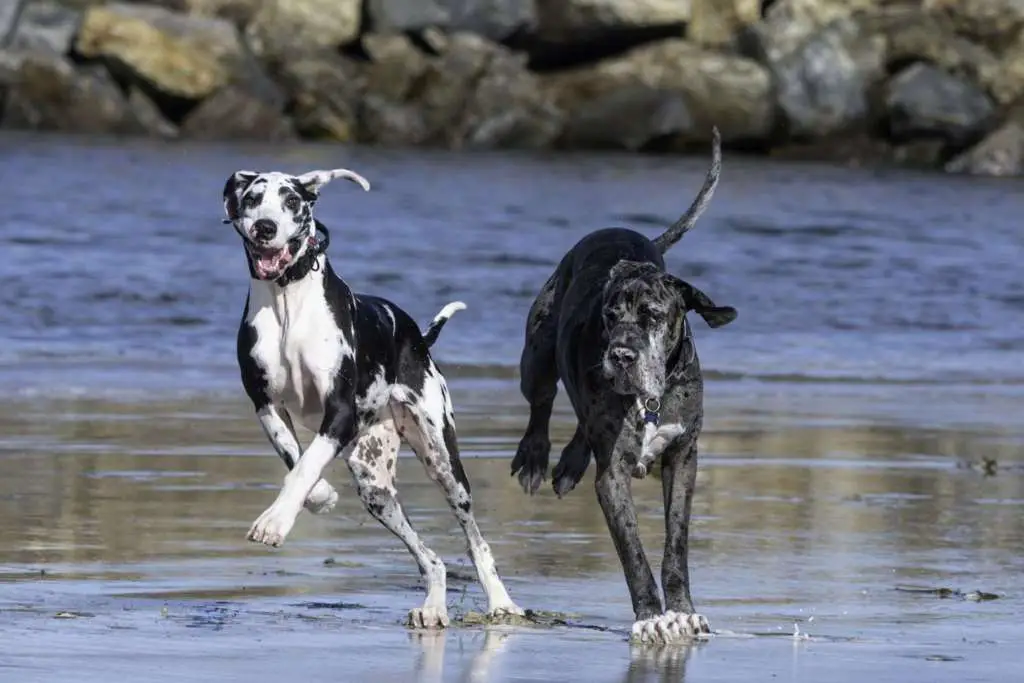
Daily Exercise Requirements for Great Danes
Great Danes might be regal, but they’re not couch potatoes. Engaging them in regular physical activities is essential to maintain their health and happiness. Here’s what their daily exercise regimen should ideally include:
- Daily Walks: A couple of brisk walks, lasting around 30 to 60 minutes each, provide them with cardiovascular exercise and mental stimulation.
- Playtime: Interactive play sessions, such as fetch or tug-of-war, encourage bonding and keep them mentally engaged.
- Gentle Jogging: A light jog can be an enjoyable form of exercise, especially when the weather is cooler.
- Swimming: If you have access to a pool, swimming is a low-impact exercise that’s gentle on their joints.
- Off-Leash Time: A secure, fenced area where they can stretch their legs and run freely is a fantastic outlet for their energy.
Low-Impact Activities for Dane’s Joint Health
- Puzzle Toys: Engage their minds and alleviate boredom with puzzle toys that challenge them to problem-solve for treats.
- Slow Strolls: While they still need regular exercise, leisurely walks are a great way to avoid overexertion and protect their joints.
- Agility Training: Set up simple obstacle courses at home to keep them active without putting too much strain on their joints.
- Gentle Fetch: Opt for a soft toy or lightweight ball for games of fetch to prevent excessive strain during retrieval.
Dane’s Mental Stimulation and Interactive Play
- Training Sessions: Mental exercise is just as important as physical activity. Regular training sessions teach commands and tricks, stimulating their intellect.
- Hide and Seek: Hide treats around the house or yard, encouraging them to use their nose to search.
- Interactive Toys: Toys that dispense treats as they play keep them engaged and mentally sharp.
- Nose Work: Introduce scent-based games where they have to find hidden items using their keen sense of smell.
By incorporating a mix of physical and mental activities into their daily routine, you’re not only keeping your Great Dane physically fit but also nurturing their cognitive health. Remember, their exercise needs evolve with age, so adapting their routine as they grow is key to ensuring their well-being and long-lasting companionship.
Grooming and Coat Care
Brushing, Bathing, and Cleaning Ears
- Brushing: Despite their short coats, Great Danes benefit from regular brushing to remove loose hair and distribute natural oils. Use a soft-bristle brush to keep their coat shiny and healthy.
- Bathing: Bathe them as needed – typically once every two to three months – using a mild dog shampoo. Be sure to dry them thoroughly to prevent skin issues.
- Ear Cleaning: Regularly check their ears for dirt, debris, or signs of infection. Use a damp cotton ball to gently clean the outer ear, avoiding inserting anything into the ear canal.
Nail Trimming and Dental Care
- Nail Trimming: Trim their nails regularly to prevent overgrowth and discomfort. Use a dog nail trimmer and take care not to cut too close to the quick.
- Dental Care: Brush their teeth a few times a week using a dog-specific toothbrush and toothpaste. This prevents dental issues and maintains their fresh breath.
Grooming isn’t just about appearance; it’s an essential part of caring for your Great Dane’s well-being. Regular grooming sessions not only keep them looking elegant but also foster a deeper bond between you and your regal companion.
Health Care and Common Medical Concerns
Regular Veterinary Check-ups and Vaccinations
- Routine Check-ups: Just like royalty requires regular check-ups, so do Great Danes. Annual visits to the veterinarian help catch any health concerns early.
- Vaccinations: Stay up-to-date with vaccinations to protect them from common canine illnesses such as rabies, distemper, and parvovirus.
Genetic Health Issues in Great Danes
| Genetic Health Issue | Description and Symptoms | Prevention Measures |
|---|---|---|
| Hip Dysplasia | Hip joint misalignment that leads to arthritis and pain. Common symptoms include limping and difficulty rising. | – Choose a reputable breeder who tests for hip dysplasia in their breeding dogs. – Maintain a healthy weight to reduce stress on the joints. – Provide joint supplements as recommended by your vet. |
| Dilated Cardiomyopathy (DCM) | Heart condition enlarging heart chambers, affecting blood pumping. Symptoms include fatigue, coughing, and rapid breathing. | – Regular veterinary check-ups with heart screenings. – Feed a high-quality, low-sodium diet recommended by your vet. – Consult your vet regarding supplements that support heart health. |
| Gastric Dilatation-Volvulus (GDV) | Stomach twisting causing bloat. Symptoms include distended abdomen, retching, and restlessness. | – Feed multiple small meals throughout the day. – Avoid vigorous exercise before and after meals. – Consider an elevated feeding station to prevent rapid eating. |
| Hypothyroidism | Underactive thyroid gland leading to weight gain, lethargy, and skin issues. | – Regular thyroid screenings through blood tests. – Consult your vet for appropriate medication and diet adjustments if needed. |
| Wobbler Syndrome | Neurological disorder affecting the spinal cord, causing coordination and mobility issues. Symptoms include unsteady gait and weakness. | – Provide a balanced diet to maintain proper growth. – Avoid excessive high-impact exercise during the puppy growth phase. – Consult your vet if you notice any unsteady movements or coordination issues. |
Understanding these genetic health issues and their prevention measures empowers you to take proactive steps in safeguarding your Great Dane’s health and well-being. Regular veterinary care, a balanced diet, and a supportive environment play crucial roles in ensuring your gentle giant leads a healthy and vibrant life.
Training and Socialization of Great Danes
Basic Obedience Training
- Sit: Teach them to sit on command, a foundational cue for manners and control.
- Stay: Train them to remain in place until given the signal to move, ensuring safety in various situations.
- Down: Teaching them to lie down helps manage their energy and provides relaxation cues.
- Come: A crucial command for recall, promoting safety during off-leash activities.
- Leave It/Drop It: Preventing them from picking up or consuming harmful objects.
Leash Manners and Handling a Strong Great Dane Dog
- Leash Walking: Train them to walk calmly on a leash without pulling, using positive reinforcement.
- Heel: Teach them to walk beside you, enhancing control during walks.
- Handling: Get them accustomed to being handled, making vet visits and grooming stress-free.
Socializing Dane with People and Other Dogs
- People: Expose them to different people of various ages, genders, and appearances to foster positive social interactions.
- Other Dogs: Controlled introductions to well-behaved dogs help them learn appropriate social cues.
Traveling With Great Danes
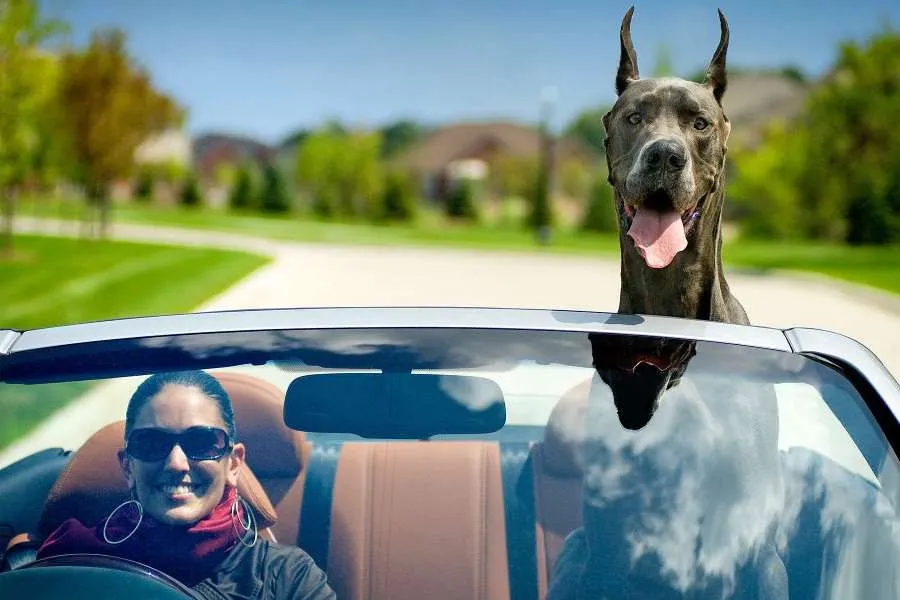
Car Safety and Transportation Tips
- Seat Belts/Harnesses: Use a seat belt or harness designed for dogs to secure them during car rides.
- Crates: A secure crate provides safety and prevents distractions while driving.
- Ventilation: Ensure proper ventilation in the car to keep them comfortable.
Accommodations While Traveling with a Great Dane Dog
- Pet-Friendly Accommodations: Research and book accommodations that welcome large dogs.
- Space: Ensure the accommodation has enough room for them to move comfortably.
Maintaining Routines During Trips
- Stick to regular feeding times and dietary habits.
- Keep exercise routines consistent to avoid disruptions in their energy levels.
- Maintain their sleep schedule for a smooth transition and well-rested travel companion.
Older Great Dane Care
Adjusting Care for Older Dogs
- Diet: Transition to a senior-specific diet to meet their changing nutritional needs.
- Exercise: Modify exercise routines to accommodate their reduced energy levels and joint health.
Health Considerations for Senior Great Danes
- Arthritis: Provide joint supplements and low-impact exercise to manage arthritis discomfort.
- Regular Vet Visits: More frequent check-ups help catch and manage age-related health issues.
- Dental Health: Continue dental care to prevent dental problems that become more common with age.
- Weight Management: Adjust their diet and exercise to prevent obesity, which can exacerbate health problems.
Understanding the needs of senior Great Danes and making necessary adjustments ensures they enjoy their golden years with comfort and quality of life.
Inspiring Great Dane Stories
Heroic and Service Great Danes
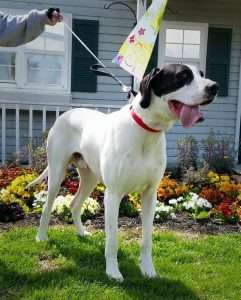
Hercules the Therapy Dog: Hercules, a gentle giant with a heart as large as his stature, embarked on a mission to spread smiles and healing. He visited hospitals, nursing homes, and rehabilitation centers, touching the lives of countless patients. With his calm demeanor and soulful eyes, Hercules had an uncanny ability to connect with individuals facing pain and adversity. One memorable moment was when he comforted a young child battling a serious illness, bringing a glimmer of happiness to a challenging situation. Hercules proved that a simple paw placed with compassion could have a profound impact on the human spirit.
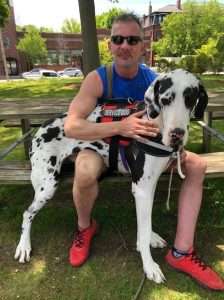
George the Service Dog: George was not just a service dog; he was a lifeline for his owner, a disabled war veteran named Mark. Mark had struggled with physical and emotional scars from his service, but George brought a new sense of purpose and independence into his life. From retrieving dropped items to providing stability during walks, George’s training and innate loyalty made him an invaluable partner. Their bond was a testament to the resilience of the human-canine connection, reminding everyone that sometimes, the greatest heroes walk on four paws.
Great Dane Rescue Stories
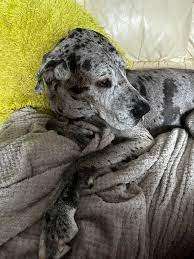
Luna’s Second Chance: Luna’s journey began in adversity, as she was rescued from a neglectful environment. Despite her past, Luna’s spirit remained unbroken. With patience, care, and a loving home, Luna underwent a remarkable transformation. Her once-shy demeanor blossomed into exuberance as she discovered the joys of love, attention, and play. Luna’s story stands as a heartwarming example of the resilience and capacity for healing that Great Danes possess when given a second chance.
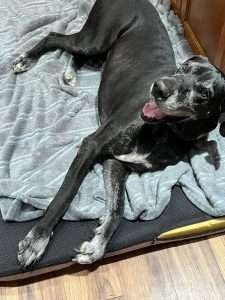
Max’s Journey: Max’s early life was marked by hardship, as he was found abandoned and malnourished. When he was adopted into a forever home, his life took a complete turnaround. Through a balanced diet, exercise, and unwavering care, Max transformed from a timid and frail pup into a vibrant, healthy Great Dane. His journey from adversity to happiness serves as a reminder that every dog has the potential to flourish with the right environment and a loving family by their side.
You might also read:
- Happy Great Dane Adoption Stories
- Lost Souls: Found! Inspiring Stories About Great Danes
- Fawn Great Dane: Everything You Need to Know
Danes’ Contributions to Popular Culture and Media
Marmaduke: This lovable Great Dane’s comic strip adventures brought laughter and warmth to readers of all ages.
Scooby-Doo: The iconic Scooby-Doo, a Great Dane with a penchant for mysteries and snacks, has captured hearts for generations.
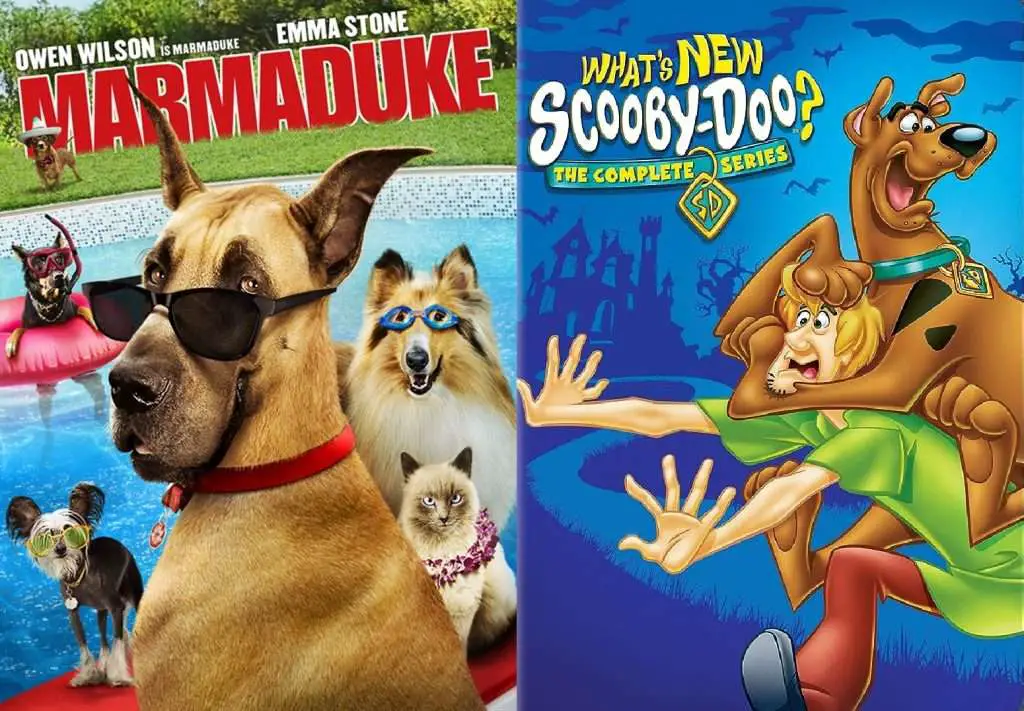
These inspiring stories remind us that Great Danes are more than just majestic dogs – they’re companions that touch lives, bring joy, and leave a lasting legacy of love and loyalty.
Forums and Communities for Great Dane Enthusiasts
Great Dane Forums:
- Great Danes Forums
- Diet (Kibble only) Forum – Great Danes Online
- What should I feed my Great Dane Puppy – Great Dane Forums
- Black great Dane – Great Dane Forums
- Danes Online
Books:
- “The Great Dane: Model of Nobility” by Jill Swedlow
- “Great Danes: Everything About Purchase, Care, Nutrition, Behavior, and Training” by Joe Stahlkuppe
Websites:
Social Media Accounts:
- Instagram: @greatdanesofinstagram
- Facebook: Great Dane Lovers Community
Conclusion
In the world of canine companions, Great Danes stand as majestic giants, captivating hearts with their regal presence and gentle nature. From understanding their history and unique traits to caring for their health and well-being, this comprehensive guide has explored every facet of life with a Great Dane.
Whether you’re a prospective owner or a devoted companion, the knowledge shared here serves as a beacon, guiding you through the adventure of welcoming a Great Dane into your home and heart. As you embark on this journey, may your bond with these gentle giants be as legendary as their stature, and may every wag of their tails remind you of the enduring joy they bring to our lives.
Great Dane FAQs
1. What is the average lifespan of a Great Dane?
- Great Danes have an average lifespan of around 8 to 10 years. Proper care, regular veterinary check-ups, and a healthy lifestyle can contribute to a longer, fulfilling life.
2. Are Great Danes good with children and other pets?
- Yes, Great Danes are generally known for their gentle and friendly nature. They can be great companions for children and get along well with other pets, provided they are properly socialized from a young age.
3. Do Great Danes require a lot of exercise?
- Despite their large size, Great Danes have moderate exercise needs. Daily walks, playtime, and mental stimulation are important, but excessive high-impact exercise should be avoided, especially during their growth period.
4. How do I prevent bloat (gastric torsion) in my Great Dane?
- Bloat is a serious concern in Great Danes. To help prevent it, feed them multiple small meals throughout the day, avoid vigorous exercise before and after meals, and consider using elevated feeding stations. Familiarize yourself with the symptoms so you can recognize it early and seek immediate veterinary care if necessary.
5. Are Great Danes easy to groom and maintain?
- Yes, Great Danes are relatively low-maintenance in terms of grooming. Their short coats require regular brushing to remove loose hair and maintain a healthy shine. Regular baths, ear cleaning, nail trimming, and dental care are also important aspects of their grooming routine.


